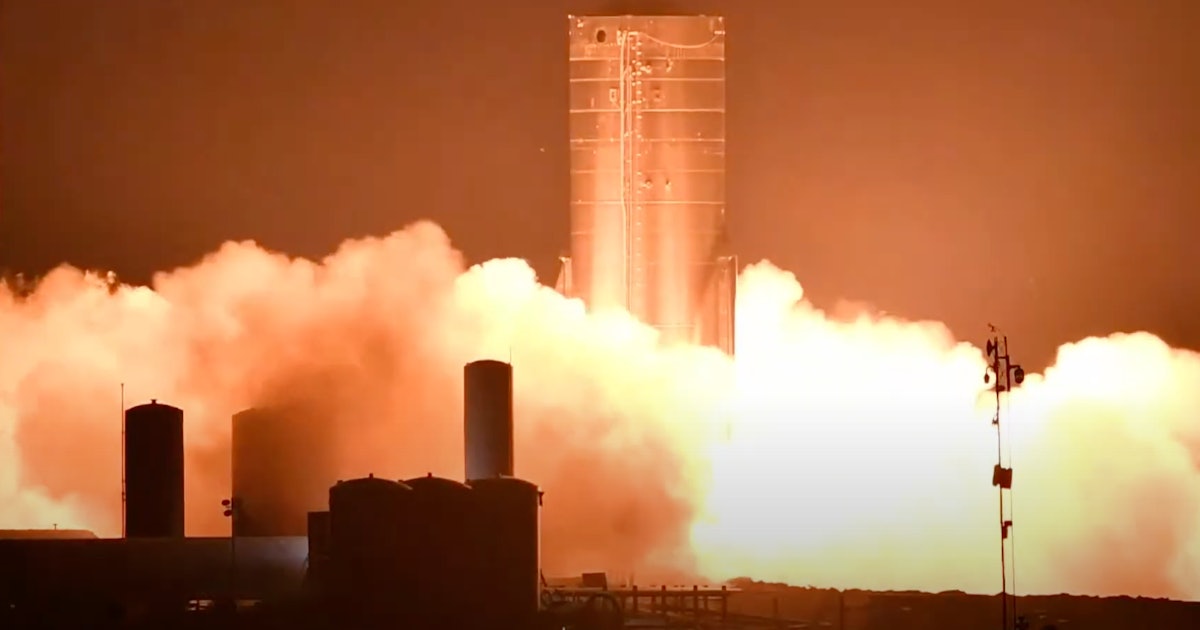
The Starship, SpaceX's under-construction spaceship, has completed its first triple-engine static test fire.
At the Boca Chica facility in Texas early Tuesday morning, Starship prototype "SN8" shook the ground as its three Raptor engines fired without launching the rocket.
This kind of test is one of the last typically done before a rocket flies. It is the first time that a Starship prototype has fired three engines as the same time, and it could be one of the last hurdles before the ship launches to new heights.
Starship is pivotal to SpaceX's future plans. The company aims to fly the ship the Moon, Mars, and beyond, with a fully-reusable design powered by liquid oxygen and methane. So far, prototypes, equipped with one engine, have flown up to 500 feet in the air. SpaceX CEO Elon Musk declared this new model could reach much higher — 15 kilometers, or around 50,000 feet.
The final model will reach greater heights. The ship will be equipped with three sea-level engines, just like SN8, and will also offer three larger vacuum Raptors for navigating space. The Super Heavy booster, which will lift the ship out of Earth's atmosphere, adds a further 28 engines to the base.
The ship itself measures around 160 feet tall and 30 feet wide, but when paired with the booster the whole ship will measure around 400 feet.
The latest firing brings this moment a little bit closer. Watch the video below:
This is unlikely to be the last static firing before launch. Musk explained last month that the team will complete checkouts after the first firing, before firing a second time ahead of the flight.
The advances have sparked the imagination of a community of artists and fans. Minnesota-based 3D artist Bart Caldwell shared a rendering last week that imagined what SN8 will look like when it launches. Caldwell explained the project "has got me dreaming again and feeling inspired about the future which is really important for me as a person and as an artist." Musk himself described Caldwell's latest work as "great."
SpaceX plans higher and higher flights ahead of a future attempt to reach orbit, tentatively slated for 2021. Speaking at the Mars Society annual convention last week, Musk suggested that it's not a certainty.
“I’m 80 to 90 percent that we will reach orbit with Starship next year," Musk said. "I think probably 50 percent confident we’ll be able to bring the ship and the booster back.”
Those first flights with the booster are unlikely to feature the full number of engines — Musk says they're more likely to attach around two or four engines to the booster instead of the full 28.
From there, SpaceX aims to hold full flights as early as 2022. The first cargo ships, designed to support a future crewed mission, could reach Mars by 2024. This is all in preparation for building a million-strong city by 2050.
The Inverse analysis — SpaceX's tests are becoming more visually dramatic. From single-engine flights with the miniaturized Starhopper back in August 2019, to sending up silo-shaped ships 12 months later, the concepts depicted in art on the company's website are slowly coming to life.
Although Musk didn't share the feat on his Twitter page — which seems to be his preferred method of revealing news — the static fire news spread like wildfire thanks to footage from NASASpaceflight and fans in the Reddit and Twitter communities.
With SpaceX expected to host a Starship-focused event sometime this month, it seems fans can't wait to see what comes next.
THE STARSHIP’S JOURNEY, SUMMARIZED
"triple" - Google News
October 20, 2020 at 09:18PM
https://ift.tt/31qHJlV
SpaceX Starship: Watch triple-engine spaceship fire for first time - Inverse
"triple" - Google News
https://ift.tt/3dc0blF
https://ift.tt/2WoIFUS
Bagikan Berita Ini















0 Response to "SpaceX Starship: Watch triple-engine spaceship fire for first time - Inverse"
Post a Comment